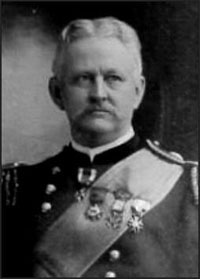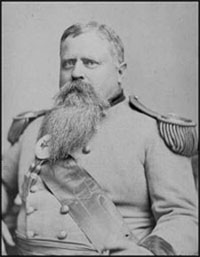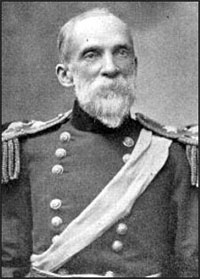This post is related to my last post on the Franco-Prussian War of 1870.
For a long time, I’ve been a bit embarrassed by just how little I knew about the Spanish-American War, so I made a conscious choice to change that after Susan and I visited Key West in October 2003. I made a point of seeking out and finding the memorial to the dead sailors of the U.S.S. Maine who were interred in the city cemetery in Key West. Interestingly, the anchor of the Maine is in my home town of Reading, PA, and I always knew that, but I knew very little about how it got there or its significance.
One thing that strikes me about what have become known as America’s Splendid Little Wars (thanks to William Randolph Hearst for that gem) is their connection to the Civil War.
 The Secretary of State in the McKinley Administration was John Hay–the same John Hay who was Lincoln’s personal secretary. Nelson Miles was the commanding general of the armies. Maj. Gen. Wesley Merritt was the highest ranking Army officer in the field, and was actually recommended for promotion to lieutenant general as a reward for his performance during the Span-Am War. The rank of lieutenant general had been retired after Sheridan’s death, so major general was, once again, the highest rank in the Army. Merritt, at the time of his retirement, was the second ranking officer in the Army as a major general. Unfortunately, lieutenant general was not reinstated in time for him to enjoy its fruits.
The Secretary of State in the McKinley Administration was John Hay–the same John Hay who was Lincoln’s personal secretary. Nelson Miles was the commanding general of the armies. Maj. Gen. Wesley Merritt was the highest ranking Army officer in the field, and was actually recommended for promotion to lieutenant general as a reward for his performance during the Span-Am War. The rank of lieutenant general had been retired after Sheridan’s death, so major general was, once again, the highest rank in the Army. Merritt, at the time of his retirement, was the second ranking officer in the Army as a major general. Unfortunately, lieutenant general was not reinstated in time for him to enjoy its fruits.
The Secretary of War in the McKinley Administration was Russell A. Alger, who had commanded the 5th Michigan Cavalry during the Civil War. McKinley, of course, was also a Civil War veteran, as evidenced by the ridiculous monument to him at Antietam.
When the drums of war began to beat again in 1898, Alger was terribly worried that Southerners would not flock to sign up as a result of remaining bitterness over losing the Civil War. So, Alger had an absolutely brilliant idea….he would recruit several former Confederate generals to don the blue uniform of the U. S. Army once again. Three of the four were now politicians, so they were safe.
 He chose Thomas L. Rosser, Fitz Lee, the governor of Virginia, Joe Wheeler, Congressman from Alabama, and Matthew C. Butler, US Senator from South Carolina. All were commissioned as major generals of volunteers. Butler, in particular, had impressed Alger during the Civil War, and, specifically, Butler’s brilliant defense at Trevilian Station, where some of Butler’s troops came within a whisper of capturing Alger during what I often describe as “Custer’s First Last Stand.” Lee weighed about 350 pounds at that point and was not fit for duty in the field, and never left the U.S. Butler had had a foot blown off at Brandy Station in June 1863, and also was unfit for duty in the field.
He chose Thomas L. Rosser, Fitz Lee, the governor of Virginia, Joe Wheeler, Congressman from Alabama, and Matthew C. Butler, US Senator from South Carolina. All were commissioned as major generals of volunteers. Butler, in particular, had impressed Alger during the Civil War, and, specifically, Butler’s brilliant defense at Trevilian Station, where some of Butler’s troops came within a whisper of capturing Alger during what I often describe as “Custer’s First Last Stand.” Lee weighed about 350 pounds at that point and was not fit for duty in the field, and never left the U.S. Butler had had a foot blown off at Brandy Station in June 1863, and also was unfit for duty in the field.
 However, unlike Lee and Butler, Wheeler, who was still vigorous and active, assumed command of the U. S. cavalry forces in Cuba and was in field command of them at San Juan Hill. It’s been reported that in the heat and excitement of battle, Wheeler slipped and referred to the Spaniards as “Yankees.” Wheeler performed so well in his role in Cuba that he was offered a commission as a brigadier general in the Regular Army, which he accepted. Wheeler was sent to assume command of U. S. forces in the Philippines when a local insurrection broke out. Wheeler did quite well in this role. Theodore J. Wint, about whom I’ve written here, served under Wheeler in the Philippines.
However, unlike Lee and Butler, Wheeler, who was still vigorous and active, assumed command of the U. S. cavalry forces in Cuba and was in field command of them at San Juan Hill. It’s been reported that in the heat and excitement of battle, Wheeler slipped and referred to the Spaniards as “Yankees.” Wheeler performed so well in his role in Cuba that he was offered a commission as a brigadier general in the Regular Army, which he accepted. Wheeler was sent to assume command of U. S. forces in the Philippines when a local insurrection broke out. Wheeler did quite well in this role. Theodore J. Wint, about whom I’ve written here, served under Wheeler in the Philippines.
On June 10, 1898, President McKinley appointed Rosser a brigadier general of United States volunteers during the Spanish-American War. His first task was training young cavalry recruits in a camp near the old Civil War battlefield of Chickamauga in northern Georgia. He was honorably discharged on October 31, 1898, and returned home.
When the Boxer Rebellion broke out in China in 1901, Brig. Gen. Adna R. Chaffee, Sr. was sent to take command. He was one of the highest-ranking officers in the Army, and was destined to become the Army chief of staff. Chaffee was badly wounded as a 21-year-old lieutenant at the July 3, 1863 Battle of Fairfield. He was brevetted for obeying a War Department order and not giving his parole when he was captured after being wounded. This began his rise to the highest echelons of the U. S. Army. Again, my guy Wint served under Chaffee, Sr. in China, and, in fact, commanded all of the Allied cavalry forces there, which included the U. S., British, and German troops.
 James Harrison Wilson, the famed Union cavalryman of the Civil War, who designed and implemented the first truly mobile strike force with his all-cavalry army of 1865, became a major general of volunteers in the Puerto Rican campaign against the Spanish, and was involved in fighting in the center of the island, near Coamo and Aibonito. Wilson retired in 1901, with the rank of brigadier general in the Regular Army.
James Harrison Wilson, the famed Union cavalryman of the Civil War, who designed and implemented the first truly mobile strike force with his all-cavalry army of 1865, became a major general of volunteers in the Puerto Rican campaign against the Spanish, and was involved in fighting in the center of the island, near Coamo and Aibonito. Wilson retired in 1901, with the rank of brigadier general in the Regular Army.
What’s particularly interesting to me about this is that of these officers, Nelson Miles was the only one who was not a cavalryman. Another interesting point is that three of the four ex-Confederates (Lee, Rosser, and Butler) were former adversaries of Alger’s, and all four of them had fought on the same field at Trevilian Station. Hmmmmm……..
There is a lot of interesting stuff to be gleaned from all of these “Splendid Little Wars,” and I am now working on learning some of it. While our present “splendid little wars” do not involve the standard form of imperialism that drove these wars of the late Nineteenth Century, we’re presently engaged in some similar conflicts around the world. I cannot help but be drawn back to the words of Alphonse Karr after the French Revolution: “Plus ça change, plus c’est la même chose.” ~ Translation: “The more things change, the more they remain the same.”
Scridb filterComments
Comments are closed.







 Back to top
Back to top Blogs I like
Blogs I like 
Yep, those splendid little steps into imperialism were a case of vu jadee alright:
Overripe, and some pretty questionable leadership at the top.
A logistical nightmare with poorly planned transport and bad distribution.
Underprepared and poorly armed National Gaurd volunteers.
More people killed by bugs than bullets.
Makes me real nostalgic for the 19th Century. 🙂
Eric,
America’s Splendid Little Wars is a great read, especially his coverage of our opns in the Phillipines. I just got my hands on “Eating Soup With a Knife” which discusses our counterinsurgency opns in Vietnam against the opns of the Brits in Malaya.
Wade
Dave,
LOL. My point precisely, and well said. 🙂
Eric
Wade,
The Philippines operations are of particular interest to me due to the role played by my guy Wint. They managed to put down a popular guerrilla movement, but it’s more because it ran out of steam then anything else. As you say, it’s an excellent work.
Eric
Eric,
I know that Hearst and his papers beat the war drums rather loudly, pushing for a war with Spain, but I thought it was John Hay himself who designated the Spanish-American War as “a splendid little war”. What say ye?
Lanny
Lanny,
I believe you are correct, and I stand corrected.
Eric
I authored the biography of Henry W Lawton in 1998. Chaffee was Lawton’s brigadier in 1898 during the Cuban campaign.
As you delve into the Spanish American War, I’ll be glad to help you in any way I can.
Rudy